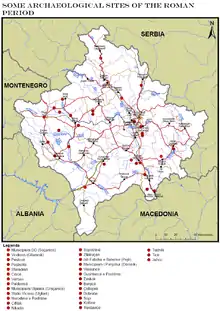Vindenis
Part of a series of articles upon Archaeology of Kosovo

Vindenis was an ancient city in Dardania in Kosovo. Among three road stations that were constructed in Dardania during the Roman Period, Statio Vindenis, is one of the identified stations. This archaeological site is set at the area of the village of Gllamnik, Municipality of Podujeva. The site is located approximately 5 km south, southeast from Podujeva. The ancient Via Lissus-Naissus Roman road was a diagonal route, connecting the central Balkans region with the Adriatic coast, which passed through Vindenis. The settlement and Roman road station of Vindenis are stretched on the right bank of Llap River vicinity, measuring an area of more or less of 15-20 hectares. During the eighties of the last century, systematic archaeological excavations carried out at this site, uncovered an area in total of 550 m2. Among recorded archaeological findings and features here, the most characteristic ones are the grave burials with the grave goods. The burial rites documented here, tell us about the practise of cremation and inhumation burial rites. Besides, a heavy marble sarcophagus was discovered, most probably especially prepared for a distinguished person of high economical, social and political status. Nonetheless, archaeological investigations identified several dwellings, and in particular a distinguished discovery of a floor mosaic composed with geometrical motifs, at the central part of the mosaic, the figural display panel of the Orpheus, makes this mosaic a special discovery. A special finding discovered at this site, is a gold wedding ring with a cameo which clearly indicates shaking of the right hands, which means an agreement but also symbolizes loyalty and friendship. Geophysical, geomagnetic surveys or prospection’s conducted at this locality in 2008 and 2011, in an area of at least 11 hectares of this important archaeological site, identified traces of remains of different objects that at the first impression, resemble to a military field garrison, most probably stationed there to protect the surrounding area and the road station. The archaeological site of Vindenis, was active during the entire period of the Roman rule as well as during the late antiquity.[1] It is one of the road stations situated between Ulpiana and Naissus drawn on the Tabula Peutingeriana.[2]
Block Quotes
Vedenich –the antique settlement Vindenis, perhaps the mediaeval village of Vidina in Kosovo
From that time (inclusion of Kosovo in the Roman province of Upper Moesia) originated The oldest map of the sights that talk about polo? case and the development of Kosovo within the Roman Empire: Ptolemy's map of Upper Moesia (II century) where, in accordance with then? Him postignuæima cartography, drawn settlements (Ulpianum, Vindenis, Vellanis and Arribantion), branch- and shall name the province, and few hydrographic and orographic elements and Tabula Peutinge- riana? first cartographic representation of Roman roads in the area of Kosovo, which posvjedoèuje ve- several traffic meaning of the Kosovo area in connecting the Aegean, Adriatic and in- Danube regions.
XIII aa O. vermuthet, das von ihm und Kanitz S. 118 bei Podujevo angesetzte Vindenis sein, für dessen städtische Verfassung kein Zeugnis vorliegt. Eher ist an Ulpiana (Lipljan) zu denken
Translation:
XIII cited suspected that he and his Kanitz p. 118 scheduled at Podujevo Vindenis, exists for the urban Constitution is not a witness. Rather is to Ulpiana (Lipljan) to think
Karte zwischen Vindenis und Naissus genannte Station Ad fines bezeichnen könnte.
Translation:
map between Vindenis and Naissus could be the station called Ad fines.
XIII IV н. н. м., Vindenis, Koje Taj паучник и Каниц стр. 110 мсЬу код Подуева, jep нема доказа да je Vindenis био град. Ире Ье бити Ulpiana (Диплан), 4nja ce облает према Нишу пружала можда до станице ad fines
Translation:
XIII n IV. n. m., Vindenis, What It paučnik and Kanitz pp. 110 msu in Podueva, jep no evidence that the city was Vindenis. Ire be Ulpiana (Diplan) 4nja will oblaet with their journey to the station may provide ad fines
The Tabula Peutingeriana notes the following stations on the road between Naissus and Lissus: Naisso XIV AdHerculem VI Hammeo XX Ad Fines XX Vindenis XIX Viciano XXV Theranda XXX Gabuleo XVII Creveni XXX Ad Picaria XXX Lissum
See also
References
- Milot Berisha, Kosovo Archaeological Guide,Prishtinë, Kosovo Archaeological Institute and Ministry of Culture, Youth and Sports, 2012, Pg.62.
- http://scindeks.nb.rs/article.aspx?artid=0459-10700646017P
- http://www.rastko.rs/kosovo/delo/11688
- http://hrcak.srce.hr/file/29155
- Österreichisches Archäologisches Institut (Vienna, Austria) R.M. Rohrer, 1900 at Google Books
- Spomenik Srpska akademija nauka i umetnosti at Google Books
- http://scindeks.nb.rs/article.aspx?artid=0459-10700646017P